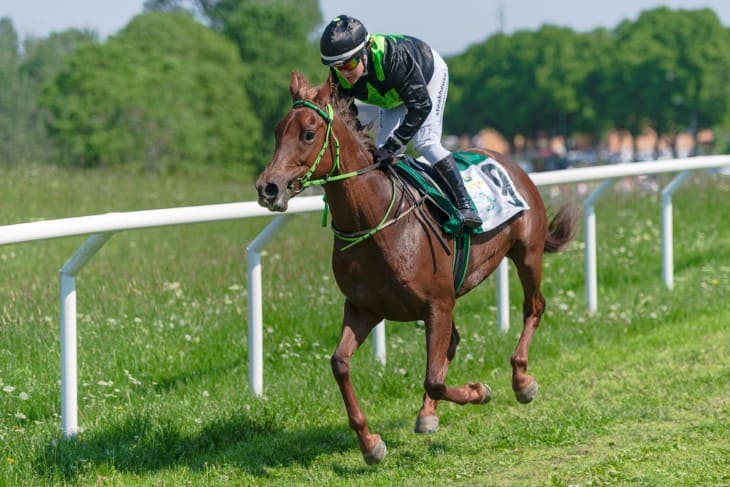- Key Components of an Effective Bullet Workout
- The Role of Bullet Workouts in a Horse's Fitness Regime
- Impact of Bullet Workouts on Race Performance
- Safety Considerations and Risks in Bullet Workouts
- Training Schedules: Integrating Bullet Workouts
- Case Studies: Real-World Examples of Successful Bullet Workouts in Horse Racing
- Views from Trainers and Jockeys on Bullet Workouts
- Conclusion
Bullet workouts are a specific type of training exercise used in horse racing, focusing on speed and endurance. Unlike regular training sessions, these workouts are shorter and more intense, designed to simulate race conditions. They typically involve a horse running at its maximum or near-maximum speed over a short distance, usually less than a mile. The term 'bullet' refers to the fastest workout of the day at a particular distance at a race track. This notation is commonly used in racing forms and track workouts.
Understanding bullet workouts requires a grasp of their structure and goals. These sessions aim to enhance a horse's speed and stamina without causing excessive strain. They are often spaced out within a horse's training schedule to allow for recovery and to build upon the horse's physical condition gradually. The effectiveness of bullet workouts lies in their ability to condition a horse to maintain high speeds over distances similar to those they will encounter in actual races, thus providing a practical and focused training method.
In the early days, bullet workouts were not as common or as well-understood as they are today. The shift towards these types of workouts coincided with a broader movement in sports training towards high-intensity interval training (HIIT). This approach, which alternates short bursts of intense activity with periods of less-intense activity or rest, has been shown to improve both speed and endurance in athletes, equine or otherwise. The adaptation of HIIT principles to horse training led to the formalisation of bullet workouts as a key component in a racehorse's preparation.
Key Components of an Effective Bullet Workout
Bullet workouts are structured to maximise a horse's racing potential, and several key components contribute to their effectiveness:
- Distance and Speed: The distance covered in a bullet workout is typically short, often ranging from a quarter mile to a half mile. The focus is on allowing the horse to run at or near its top speed, providing a simulation of the high-speed conditions experienced in a race.
- Frequency and Timing: These workouts are not daily occurrences; they are strategically spaced in a horse's training schedule. The timing is crucial — too frequent, and the horse risks injury or burnout; too infrequent, and the benefits may not be fully realised.
- Monitoring and Assessment: Trainers closely monitor a horse's response to bullet workouts. This includes assessing physical signs of exertion and recovery, as well as using technology to track performance metrics like speed, heart rate, and stride length.
- Customisation: Each horse is unique, and so are their training needs. Effective bullet workouts are tailored to the individual horse, taking into account factors like age, race history, and physical condition.
In essence, an effective bullet workout strikes a balance between intensity and recovery, customised to the individual needs of the horse. It's a delicate balance, requiring careful planning and execution by experienced trainers.
The Role of Bullet Workouts in a Horse's Fitness Regime
Bullet workouts play a crucial role in a horse's overall fitness regime, complementing other training exercises:
- Enhancing Speed: The primary aim of bullet workouts is to increase the horse's speed. By training at high speeds, the horse develops faster muscle twitch fibres, essential for quick starts and sustained speed during a race.
- Building Stamina: Despite their short duration, these workouts are intense and help build a horse's stamina. The ability to maintain high speed over the course of a race is as important as the speed itself.
- Mental Conditioning: Bullet workouts also contribute to a horse's mental conditioning. They help the animal get accustomed to the high-pressure environment of racing, teaching it to focus and perform under stress.
- Complementing Longer Workouts: These intense, short sessions are typically part of a broader training regime that includes longer, less intense workouts. The combination of both ensures that a horse develops not just speed and stamina, but also endurance and resilience.
Therefore, bullet workouts are a critical component of a comprehensive training programme, designed to optimise a horse's racing performance by improving speed, building stamina, and enhancing mental fortitude.

Impact of Bullet Workouts on Race Performance
The impact of bullet workouts on race performance is significant and multi-faceted. Firstly, these workouts fine-tune a horse's speed, a crucial factor in racing. Horses that consistently participate in bullet workouts often demonstrate exceptional bursts of speed during races, a direct result of their high-intensity training. This speed training is particularly beneficial in races where a strong, fast start or a powerful finish is essential for victory.
Secondly, bullet workouts contribute to the overall physical conditioning of a horse. Regular participation in these exercises leads to improved muscle strength and cardiovascular fitness, enhancing the horse's ability to sustain high speeds over the course of a race. The physical benefits gained from these workouts are not only evident in the horse's performance but also in its ability to recover quickly post-race, an important aspect for maintaining a healthy and long racing career.
Safety Considerations and Risks in Bullet Workouts
While bullet workouts are an integral part of horse racing training, they are not without risks, necessitating careful management to ensure the safety of the horse:
- Risk of Injury: The high-speed nature of bullet workouts puts significant strain on a horse's muscles, tendons, and bones, increasing the risk of injuries such as strains, sprains, or fractures.
- Monitoring for Overtraining: Overtraining can lead to fatigue, decreased performance, and a higher likelihood of injury. Trainers must be vigilant in monitoring their horses for signs of overtraining and adjust their workout regimes accordingly.
- Importance of a Proper Warm-Up and Cool-Down: To minimise the risk of injury, each bullet workout should be preceded by a proper warm-up and followed by a cool-down period. This helps in preparing the horse’s body for the intense exercise and aids in recovery afterward.
- Customised Training Plans: Recognising that each horse is different, trainers must develop customised training plans that consider the individual horse's condition, age, and race history. This personalised approach helps in reducing the risk of injuries and maximising the benefits of the workouts.
Safety in bullet workouts is paramount. Trainers need to balance the need for intensive training with the well-being of the horse, ensuring that these workouts are conducted in a controlled and safe environment.
Training Schedules: Integrating Bullet Workouts
Integrating bullet workouts into a horse's training schedule requires strategic planning. These intense sessions must be carefully balanced with other training elements to ensure overall fitness and well-being of the horse. Typically, bullet workouts are interspersed with longer, less intense exercises focused on endurance and recovery. The frequency of bullet workouts varies but is often guided by the horse's racing schedule, physical condition, and individual response to training.
The art of scheduling lies in understanding the horse's needs and responses. Trainers often use a combination of observation and data from fitness trackers to gauge a horse's recovery and readiness for intense workouts. A well-planned schedule ensures that the horse peaks in terms of fitness and performance at the right time, particularly leading up to major races. This holistic approach to training, where bullet workouts are a part of a diverse training regimen, contributes significantly to a horse's success on the racetrack.

Case Studies: Real-World Examples of Successful Bullet Workouts in Horse Racing
Several real-world examples underscore the effectiveness of bullet workouts in enhancing racehorse performance:
- Case Study 1 - "Sea the Stars" (2009): Sea the Stars, one of the most successful racehorses, underwent a series of bullet workouts before his remarkable season in 2009. His training included short, intense runs that contributed significantly to his victories in six Group 1 races, including the Epsom Derby, the 2000 Guineas, and the Prix de l'Arc de Triomphe.
- Case Study 2 - "American Pharoah" (2015): American Pharoah, the first Triple Crown winner in 37 years, incorporated bullet workouts as a key part of his training. Leading up to his historic wins, these workouts were crucial in developing his explosive speed and endurance, evident in his performances in the Kentucky Derby, Preakness Stakes, and Belmont Stakes.
- Case Study 3 - "Winx" (2015-2019): Winx, an Australian racing legend known for her 33 consecutive victories, often engaged in bullet workouts. These sessions played a significant role in maintaining her top form over four racing seasons, leading to her remarkable win streak and her status as one of the greatest racehorses of all time.
- Case Study 4 - "Frankel" (2010-2012): Frankel, unbeaten in his 14-race career, regularly participated in bullet workouts. These intense training sessions were pivotal in developing his legendary speed and stamina, contributing to his dominance on the racetrack and his rating as one of the best racehorses in history.
These case studies demonstrate the tangible impact of bullet workouts in preparing racehorses for high-level competition. By incorporating these intense training sessions, each horse was able to achieve remarkable speed, stamina, and racing success, showcasing the effectiveness of bullet workouts in the world of horse racing.
Views from Trainers and Jockeys on Bullet Workouts
Trainers and jockeys, being at the forefront of horse racing, offer valuable insights into the effectiveness of bullet workouts:
- Trainers' Perspectives: Many trainers advocate for the strategic use of bullet workouts, citing improvements in speed, agility, and race performance. They emphasise the importance of individualising these workouts to suit each horse's specific needs and capabilities. Trainers also highlight the need for careful monitoring to prevent overtraining and injury.
- Jockeys' Observations: Jockeys often report noticeable differences in horses that undergo regular bullet workouts. They observe enhanced speed and responsiveness during races, which can be crucial in competitive situations. Additionally, jockeys appreciate the mental conditioning that these workouts provide, making horses more adaptable and focused in high-pressure race environments.
Both trainers and jockeys agree on the value of bullet workouts when executed with consideration for the horse's physical and mental well-being. Their firsthand experiences underscore the significance of these workouts in preparing horses for the demands of competitive racing.
Conclusion
In conclusion, bullet workouts hold a critical place in modern horse racing. They provide a focused and efficient means of enhancing a horse's speed, a key determinant in race outcomes. These workouts, when implemented judiciously and tailored to individual needs, offer a competitive edge that is difficult to replicate through other training methods. The future of bullet workouts, intertwined with technological advancements and a growing emphasis on horse welfare, suggests an evolving landscape where these exercises will continue to be refined for greater efficacy and safety.
For more information:








